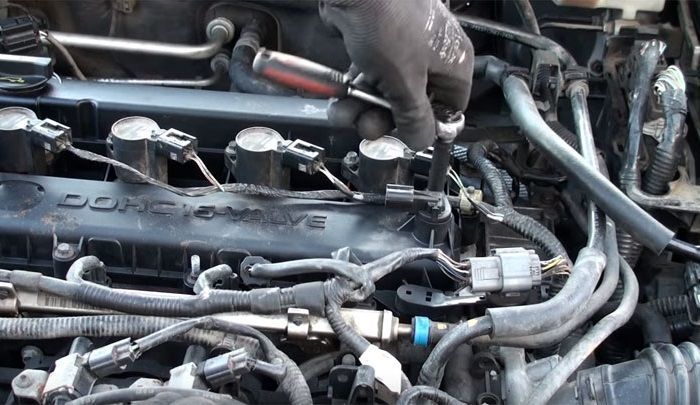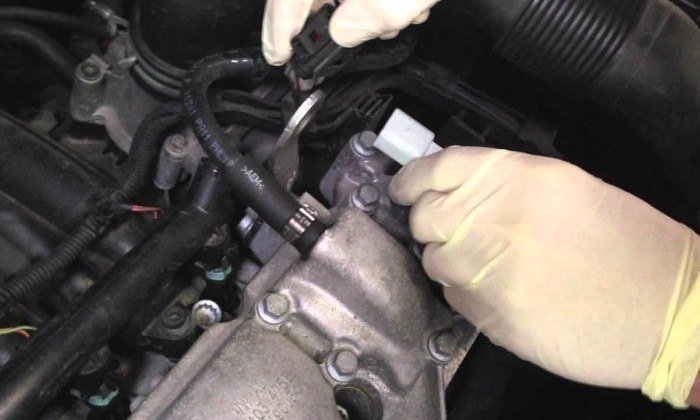by Joshua Thomas
Modern vehicles are highly reliant on computers and other electronics, and to make sure the computer is supplied with proper and enough information, the vehicles will be fitted with several sensors.
One of those sensors that you will get in all modern vehicles is the camshaft position sensor, which is designed to deliver important readings to the computer to ensure the smooth functioning of the engine.
Since the camshaft position sensor works constantly as you drive your vehicle, it is likely to fail at some point due to natural wear and tear and the abuse that comes with constant use.
Hence, it is important to know the symptoms to watch out for to know when you have a faulty camshaft position sensor. Here we explain these symptoms in more detail and show you how to replace a bad camshaft position sensor.
Contents

Before we get into the symptoms of a camshaft position sensor failure, it is important to first make it clear what it is and what it does as this is not always obvious for many motorists.
To simply state it, the camshaft position sensor is the sensor on the vehicle's drivetrain that will tell the computer the position and speed of the camshaft. This data is then used by the computer to determine both ignition and fuel injection timing.
Also, the camshaft position sensor will work with the crankshaft position sensor to help with other important things such as determining when the intake valves should be opened.

Given the crucial role that the camshaft position sensor plays in your vehicle, it is important to make sure that it always remains in good working condition. And the best way to do this is by identifying any issues in good time. This should be easy as you only need to watch out for the following symptoms.
When your camshaft position sensor starts developing issues, one of the first symptoms will be the check engine light coming on.
But, the problem with this symptom is that it can be as a result of a long list of things, and so to be sure that this specific sensor has issues, you will still need to check for another symptom.
Also, using an OBD2 scanner can be very helpful because the error code that you will get from the scan will be more specific on what caused the check engine light to come on.
Read More: How to Reset Check Engine Light
If there is one thing that many motorists dread is a vehicle that will not start as it always seems to happen at the wrong time such as when you are late for something.
Like the check engine light, there are almost countless things that can prevent the vehicle from starting. But, what many motorists might not know is that a faulty camshaft position sensor can also prevent the vehicle from starting.
A faulty sensor might send the wrong information to the computer, which in turn brings about ignition issues that make it hard to start the vehicle.
While a vehicle that will not start is super annoying, an even bigger problem that can come with a bad camshaft position sensor is an engine stall.
An engine stall can happen any time when you have issues with your vehicle even when driving at high speeds and hence it is crucial to fix any underlying issues that can result in a stall immediately.
What causes the engine to stop or stall when you have a faulty camshaft position sensor is the fact that the computer will not be telling the fuel injectors to add fuel to the engine cylinders since it is not getting the right information from the sensor.
If you drive your vehicle often enough it will be easy to notice even the slightest changes in how it drives. Hence, if you notice that it just does not drive as it usually does, this can be a sign that you have a bad camshaft position sensor.
Some of the common indicators of changes in how your vehicle drives include things like stalling frequently, slower acceleration and drop in engine power.
Indeed, these changes can also be a result of other issues, but you will not know until you inspect the vehicle thoroughly. But if they are combined with other symptoms listed on this list, then there is almost no doubt that you have a camshaft position sensor failure.
With many automatic transmission vehicles, a faulty camshaft position often leads to the vehicle being locked in one gear. You will not be able to change the gear unless you switch off the vehicle and shift the gear before starting it again, which can be quite tedious.
Even if you can change the gear by switching off the vehicle, this is often just a temporary solution because once the vehicle is running, it will be locked in one gear again.
To make things even worse, the computer in some vehicles can even put them in limp mode which will not allow you to accelerate beyond a particular speed.
A bad camshaft position sensor can also result in the injectors putting more fuel into the cylinder chamber than necessary which then leads to bad fuel economy.
Also, the faulty sensor will cause a lot of fuel to go into the wrong chamber which leads to wastage. Worst yet, ignition in the cylinder with the extra fuel will also result in a large explosion that results in more engine wear and tear. And so if you notice that your gas mileage worsens, then you might have an issue with this sensor.
This symptom can be very useful in situations where the vehicle still manages to run relatively normally even with the faulty camshaft position sensor.

When you ascertain that you have an issue with your camshaft position sensor, in most instances there is almost nothing else you can do besides replacing it as repairs hardly ever work.
While a professional mechanic will be the best option for the replacement, it is still possible to do it on your own if you have at least moderate mechanic skills, and you only have to follow a few easy steps.
Directions
The first step is to switch off the engine and allow the vehicle to cool down for a few minutes to ensure that it will be safe for you to work under the hood. And once the engine has cooled off, you should pop the hood and start by disconnecting the battery terminals.
The next step and perhaps where the inexperienced motorists might have some difficulties will be locating the camshaft position sensor. Things are even harder for those that do not know how it looks like, but a quick online search or referring to the vehicle manual should give you some idea of what to look for.
While the sensor may be located in different places on different vehicle models, it will typically be on the rear or top, the front part of the engine. And most will have around 2 or 3 wire connectors attached to them.
Once you locate the camshaft position sensor, you can go ahead and remove the wire connectors. In many instances, you will only have to release a tab on the sensor to free the wires from it.
For some vehicle models, there will also be a small security clip that you need to remove first with a screwdriver before you can get to the release tab.
The next step is now to remove the camshaft position sensor and to do this, you need to first remove the mounting bolt that is used to attach it to the engine. It will often be either 8 mm or 10 mm, and so you need an appropriate wrench.
With the bolt removed, you can now pull off the sensor with a slight twist while making sure you do not accidentally bump it into other surrounding engine parts.
Now you can install the new camshaft position sensor, and this should be as easy as removing the old one if not easier.
Start by lubricating the O-ring on the new sensor using some engine oil and then install it in the exact position the other one was placed before securing it with mounting bolt. And it is always worth double-checking your new sensor to ensure it is the correct one for your vehicle.
Step 6: Reconnect the Connectors and Battery
With the new sensor in place, you can now reconnect the wire connectors to their original position, and make sure you make them tight enough as any loose connection will come with new challenges.
Also, do not forget to reconnect the security clip if your vehicle model includes one for the sensor. And once this is done, you can reconnect the battery terminal.
In some instances, you might also have to clear out the check engine light manually using an OBD 2 scanner if the light does not switch automatically when you fix the sensor. But, if you have a scanner, this should only take a few minutes and is quite straightforward.
Note: When you take your vehicle to the auto repair shop for things like tune-up or routing, most mechanics will not check the camshaft position sensor unless asked to. Hence, if you see any of the symptoms explained above or even just suspect your camshaft position might be faulty, it is important to let your mechanic know.
Camshaft position sensors are among the most important sensors in your vehicle as they will help to ensure smooth operation, and this is more so when it comes to acceleration and deceleration. Hence, you need to keep this sensor working well at all times.
With this piece to help you out, you should now have an idea of the symptoms that will come with a bad sensor. It is important to watch out for these symptoms and have the problem fixed soonest possible to prevent more serious engine problems.
Also, replacing the camshaft position sensor is a fairly easy process, and so you will not always have to take it to the auto repair shop, which means it does not have to cost much.
 |
 |
 |
 |

About Joshua Thomas
Joshua Thomas just simply loves cars and willing to work on them whenever there's chance... sometimes for free.
He started CarCareTotal back in 2017 from the advices of total strangers who witnessed his amazing skills in car repairs here and there.
His goal with this creation is to help car owners better learn how to maintain and repair their cars; as such, the site would cover alot of areas: troubleshooting, product recommendations, tips & tricks.
Joshua received Bachelor of Science in Mechanical Engineering at San Diego State University.